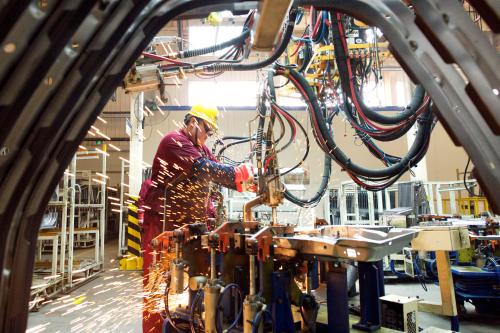We are living in an era of major technological change, led by the digital revolution. Yet, paradoxically, across major economies, while new technologies have boomed, productivity growth has declined, slowing the main engine of economic growth. Income and wealth inequalities have risen. The proverbial economic pie has been growing more slowly and more unequally, feeding today’s social discontent and political divisiveness.
Advanced tech but slower and unequal growth
Recent U.S. experience vividly illustrates these outcomes. The United States has been the global leader in the digital revolution. Yet, productivity growth has slowed since the early 2000s. Over the past decade, average labor productivity growth in the U.S. has been lower than half of what it was in the previous decade. Since the 1980s, income inequality has increased sharply. The income share of the richest 1 percent has more than doubled to 22 percent, with the wealth share rising to 40 percent. Income has shifted from labor to capital, and the distribution of both labor and capital income has become more unequal. Economic growth has picked up recently, but the underlying productivity trajectory remains weak. And inequalities have continued to mount.
Are the slowdown in productivity and the rise in inequality merely coincident trends, or are they driven by some common factors? While most researchers examine these trends separately, a just-published report, based on a joint research project between the Global Economy and Development program at Brookings and the Chumir Foundation for Ethics in Leadership, explores linkages between these trends and attempts to develop an integrated narrative.
“Productive Equity: The Twin Challenges of Reviving Productivity and Reducing Inequality,” which I contributed to, finds that the slowdown in productivity growth and the rise in income inequality are linked by common causes and call for common solutions. Chief among the causes is the interplay between technology and policies. The potential benefits of technological change have not been harnessed effectively to foster more robust and more inclusive economic growth.
The figure below summarizes the shared dynamics between productivity and equity and related common policy agenda, which the report integrates under its overarching theme (and title) of “productive equity.”
Weakening technology diffusion and competition and rising rents
At its root, the slowdown in productivity reflects a growing inequality in productivity performance between firms. Productivity growth has remained relatively robust in firms at the technological frontier but has slowed considerably in the vast majority of other firms. The benefits of the new technologies have been captured largely by a small number of firms. Aggregate productivity growth is lower in industries with wider inter-firm divergence in productivity. Barriers to a broader diffusion of the new technologies across firms are producing outcomes that are both inefficient and unequal.
Industrial concentration and corporate market power have increased, and this shift has been particularly pronounced in the U.S. Part of this reflects the winner-takes-most outcomes of the digital economy. Scale economies, network effects, and the leverage of big data associated with digital technologies encourage the rise of superstar firms. Once in dominant positions, the winners tend to entrench themselves through a variety of means that limit competition. Competition policy failures added to the shift in markets toward more monopolistic structures. Business dynamism, as reflected in new firm formation, has declined. In industries less exposed to competition, productivity gaps between firms are wider and overall productivity growth is slower.
Diminished competitive intensity in markets increased economic rents (profits in excess of those under competitive market conditions) and reduced incentives to innovate and make new productivity-enhancing investment, which partly explains the persistent weakness of investment in recent years. It also hindered the wider dissemination of technological advances. The distribution of corporate profits became more unequal. Inefficient and unequal outcomes resulting from decreased competition in product markets were compounded by resource misallocations and rents associated with rapid financialization.
Labor market disruption and skills mismatches
A similar interplay between advancing technology but slowing productivity and rising inequality has occurred in labor markets. Increased inequalities in firm productivity and profits are mirrored by increased inequalities in labor incomes. As productivity and profitability gaps widened between firms, so did wage gaps. Also, industries experiencing higher market concentration and earning higher rents saw greater decoupling of wages from firm profitability and larger drops in labor’s share of income.
Digitization and automation have shifted demand from routine low- and middle-level skills to new, higher-level technical, professional, and managerial skills. Globalization has exerted pressure in the same direction. The supply of skills, however, has been slow to adapt. Education and training have been losing the race with technology.
The lag in the supply of skills relative to shifting demand hampered the broader adoption of new technologies that require new skills, limiting productivity gains. Workers with skills that complement and align with the new technologies increasingly clustered in a few dominant firms. The relative scarcity of higher-level skills sharply increased skill premia and wage differentials, contributing to higher inequality. Again, these trends have been especially acute in the U.S.
Disruption poses tough challenges, but isn’t a cause for despair
In sum, technological change recently has not delivered its full potential in boosting productivity and economic growth. And it has pushed income inequalities higher, and generated fears about massive job losses from automation. This should not, however, provoke despair, much less a negative backlash.
Advances in digital technologies hold great promise to boost productivity and economic growth, create new and better jobs to replace old ones, and enhance human welfare. As much as two-thirds of potential productivity growth in major economies over the next decade could flow from these advances. True, technological change is inherently disruptive, creates winners and losers, and entails difficult transitions. But policies have a crucial role to play in ensuring that the potential gains are captured effectively and inclusively—by improving the enabling environment for firms and workers to broaden access to the new opportunities that come with technological change and to enhance capabilities to adjust to the new challenges. Unfortunately, policies and institutions have been slow to rise to the new challenges of the digital economy.
Policies to unlock the unmet promise of technological change
There is an agenda for change that harnesses technology to achieve better outcomes for productivity, growth, and income distribution than seen recently.
- Competition policies should be revamped for the digital age to ensure that markets continue to provide an open and level playing field for firms, keep competition strong, and check the growth of monopolistic structures. This includes regulatory reform and stronger antitrust enforcement. The digital economy is raising new challenges that competition policies will need to address, including regulatory responses to proprietary agglomeration of data, two-sided markets, market concentration resulting from tech giants that resemble natural or quasi-natural monopolies, and cross-border issues posed by tech giants that typically are multinationals that affect market concentration and competition in many countries.
- With the intangible asset of knowledge becoming an increasingly important driver of economic success, the innovation ecosystem should be improved to foster broader diffusion of advances in knowledge embodied in new technologies. Patent regimes should be reformed to better balance incumbent interests and promotion of wider economic impacts. Declining public investment in research and development should be revitalized. Infrastructure that supports digitization should be strengthened.
- Investment in skills must be boosted, with stronger programs for worker upskilling, reskilling, and lifelong learning that respond to shifts in the demand for skills. This will require innovations in the content, delivery, and financing of (re)training, including new models of public-private partnership. Persistent inequalities in access to education and training opportunities must be addressed. Labor market policies and social protection systems should be adapted to the realities of a changing world of work. These reforms could amount to an overhaul of social contracts.
- Tax policies should be reviewed in light of the new tax challenges of the digital economy, the rise of economic rents, and the income distribution dynamics. Tax and transfer systems have seen an erosion of their redistributive role, which added to the rise in income and wealth inequalities. There is scope for reforms that improve both the efficiency and equity of the tax and transfer systems.
- The dominant part of the agenda for change to make technology—and globalization—work better for all lies at the national level. But reforms are needed at the international level as well so that rules of engagement between countries in trade and other areas are fair. Not only must past gains in establishing a rules-based international system be protected from the recent rise of nationalist and protectionist sentiment, but new disciplines and cooperative arrangements must be devised to underpin the next phase of globalization led by digital flows.
Time to put to rest the false growth-equity dichotomy
The politics of reform is inevitably complex. Reform may seem even more daunting in the current political climate. But one thing reform action should not be paralyzed by is continued trite debates about conflicts between growth and equity. Research has increasingly shown this to be a false dichotomy.
Policies will need to be more responsive to change. And change will only intensify as artificial intelligence and cyber-physical systems take the digital revolution to another level. The era of smart machines will demand smarter policies.









Commentary
Harnessing technology for more robust and inclusive growth: An agenda for change
June 3, 2019